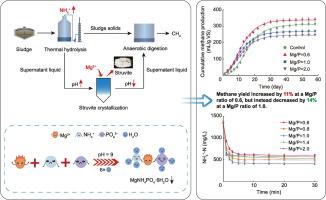Struvite crystallization eliminates ammonia inhibition in thermal hydrolysis of waste activated sludge: Role of Mg/P ratio
IF 6.3
2区 工程技术
Q1 ENGINEERING, CHEMICAL
引用次数: 0
Abstract
Thermal hydrolysis (TH) is a promising sludge pretreatment technology, but the ammonia it produces can be hazardous to subsequent anaerobic digestion (AD). This study assessed the potential of using struvite crystallization to mitigate ammonia inhibition in the AD process and examined the impact of the Mg/P ratio. The Mg/P ratio of 1.0 effectively reduced the ammonia concentration to 409 ± 22 mg/L, although methane production decreased by 14 %. Reducing the Mg/P ratio to 0.6 resulted in an 11 % increase in methane production. The study revealed that an excess of Mg2+ hindered sludge solubilization and inhibited the AD process by reducing enzyme activities, which led to a microbial community detrimental to methane production. This study provides a new idea to alleviate the ammonia inhibition of sludge AD, which is of great scientific value and practical significance for applying of struvite crystallization to TH.

在废物活性污泥的热水解过程中,硬石膏结晶消除了氨抑制:镁/磷比例的作用
热水解(TH)是一种前景广阔的污泥预处理技术,但其产生的氨可能会对后续的厌氧消化(AD)造成危害。本研究评估了在厌氧消化(AD)过程中利用铁矾石结晶缓解氨抑制的潜力,并考察了 Mg/P 比率的影响。Mg/P 比率为 1.0 时,可有效将氨浓度降至 409 ± 22 mg/L,但甲烷产量减少了 14%。将 Mg/P 比率降低到 0.6 后,甲烷产量增加了 11%。研究表明,过量的 Mg2+ 会阻碍污泥溶解,并通过降低酶活性抑制厌氧消化(AD)过程,从而导致不利于甲烷生产的微生物群落。该研究为缓解污泥厌氧消化(AD)过程中的氨抑制作用提供了新思路,对将硬石膏结晶应用于 TH 具有重要的科学价值和现实意义。
本文章由计算机程序翻译,如有差异,请以英文原文为准。
求助全文
约1分钟内获得全文
求助全文
来源期刊

Journal of water process engineering
Biochemistry, Genetics and Molecular Biology-Biotechnology
CiteScore
10.70
自引率
8.60%
发文量
846
审稿时长
24 days
期刊介绍:
The Journal of Water Process Engineering aims to publish refereed, high-quality research papers with significant novelty and impact in all areas of the engineering of water and wastewater processing . Papers on advanced and novel treatment processes and technologies are particularly welcome. The Journal considers papers in areas such as nanotechnology and biotechnology applications in water, novel oxidation and separation processes, membrane processes (except those for desalination) , catalytic processes for the removal of water contaminants, sustainable processes, water reuse and recycling, water use and wastewater minimization, integrated/hybrid technology, process modeling of water treatment and novel treatment processes. Submissions on the subject of adsorbents, including standard measurements of adsorption kinetics and equilibrium will only be considered if there is a genuine case for novelty and contribution, for example highly novel, sustainable adsorbents and their use: papers on activated carbon-type materials derived from natural matter, or surfactant-modified clays and related minerals, would not fulfil this criterion. The Journal particularly welcomes contributions involving environmentally, economically and socially sustainable technology for water treatment, including those which are energy-efficient, with minimal or no chemical consumption, and capable of water recycling and reuse that minimizes the direct disposal of wastewater to the aquatic environment. Papers that describe novel ideas for solving issues related to water quality and availability are also welcome, as are those that show the transfer of techniques from other disciplines. The Journal will consider papers dealing with processes for various water matrices including drinking water (except desalination), domestic, urban and industrial wastewaters, in addition to their residues. It is expected that the journal will be of particular relevance to chemical and process engineers working in the field. The Journal welcomes Full Text papers, Short Communications, State-of-the-Art Reviews and Letters to Editors and Case Studies
 求助内容:
求助内容: 应助结果提醒方式:
应助结果提醒方式:


